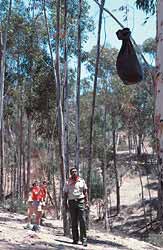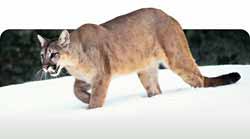Claws, Teeth, Horns, and Hooves: Dodging Dangerous Wildlife
By F. Lynne Bachleda
Although deadly confrontations are rare, you should know how to react to any unlikely encounter with bears, mountain lions, or large, hoofed animals.
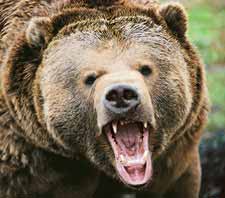 Bears, both grizzly (above) and black, are astonishingly strong, lightning fast, and able to run for miles. They are also exceptionally maternal; so do not go anywhere remotely near a cub (below) or its mother. All Images File Photos 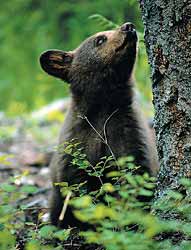
|
The outdoors, especially at night, seems full of thrilling and sometimes scary possibilities. What critters lurk out there? What can they do to you?
First, understand that deadly confrontations between humans and other mammals such as bears, mountain lions, and large, hoofed animals are actually very rare. And the right information will prepare you to know which animals can be dangerous and how to react if and when you encounter them.
Our comfortable lives often divorce us from the gritty reality that wild animals face daily. Consider the point of view of the animal to help both of you in a potentially dangerous situation.
Do not:
- Crowd, tease, handle, or physically abuse animals.
- Approach offspring when elders are present, remembering that animals can be camouflaged.
- Encroach upon feeding animals.
- Disturb wild animals that are mating.
- Try to feed wildlife or leave or bury garbage (which they will certainly find).
- Approach offspring when elders are present, remembering that animals can be camouflaged.
The Bear Necessities
In the continental United States, your risk of encountering black or grizzly bears is small. As bear authority Kevin van Tighem has observed, "The risk of a car accident on the way to bear country far outstrips the chance of a close-range encounter with a bear."
It is true, however, that both species have killed people. And, under certain conditions, bears may have to range more widely for food, increasing the likelihood of an encounter with humans.
Bears have an extraordinarily acute sense of smell, so watch for bears and know your position in relationship to the wind. Leave strongly scented items such as soaps, deodorants, insect repellents, bacon, cheese, fish, and fresh meats at home or store them with extreme care.
Bears like snacks, such as gum and candy, too. Store these items in a bear bag, hung at least 12 feet above the ground and well away from your campsite.
Never, under any circumstances, feed bears!
Bears have astonishing strength. According to expert Stephen Herrero, "Trying to physically subdue an enraged adult black or grizzly bear is like wrestling with a tank."
Belying their lumbering gait, bears are also lightning fast. A provoked bear can knock you 15 feet in one blow and be on you before you stop rolling. They are capable of running for miles at 25 to 40 miles per hour over varied terrain. You cannot outrun a bear, and it is a grave mistake to try.
Both species are extremely bright and curious, and exceptionally maternal, too. Do not go anywhere near a mother and her cub. If she remotely perceives a threat, your encounter may turn swiftly violent.
But do not assume that interest from a bear means imminent trouble. When a bear stands up, it may only be gathering information by smell and sight.
Below are some actions to take when in bear country:
- Hike in groups, making noise to discourage bears from approaching.
- If you see a bear, stop and look for cubs. If you see cubs, slowly back away, communicating that you are not a threat to the cubs. Do not turn and run, which makes you look like prey.
- Notice circling vultures, which can mean carrion and a bear nearby, ready to defend its food.
- Constantly look for bears in the distance. If you see one, make a wide detour and leave the area immediately without running.
- In the backcountry, cook and eat well away from your tent. Clean up immediately and thoroughly. Pack out garbage, burning only paper and wood.
- Wash food from your face and hands and hang food-soiled clothing beyond bears' reach.
- Open tent flaps when leaving a campsite so bears can easily look inside.
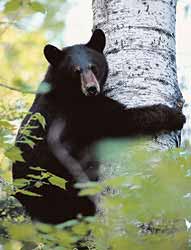 It's important to distinguish between a black bear (above) and a grizzly (below). 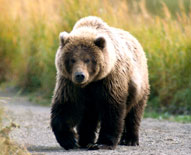
|
Black Bear Or Grizzly?
It is essential to distinguish between black and grizzly bears, because their strategies and your responses are quite different. Do not rely on size or color for identification.
Black bear attributes:
- Comparatively more elongated, larger ears.
- Snout and forehead in a relatively smooth line.
- Smooth throat.
- Little or no shoulder hump and a rump slightly higher than shoulders.
Grizzly bear attributes:
- Comparatively smaller, more rounded ears.
- Snout protruding from a dish-shaped face.
- Rough hairs on throat.
- Pronounced hump at the shoulders tapering to rump.
Fatal encounters with black bears are rare. Motivated by predation, they happen in the backcountry while individual humans hunt, pick berries, or fish. Most black bear encounters happen not around a campfire, but when people try to feed, tease, or photograph them at close range.
When startled, black bears may swat the ground, make loud blowing noises, or initiate a short charge that stops short of an attack.
If you are attacked by a black bear:
- Yell and fight the bear with the closest weapon—a heavy stick, rock, ax, fists, and feet.
- Make sure the bear has an escape route.
- Head for shelter if it is nearby. (A tent is not a shelter.)
- Do not run if shelter is not immediately available. Black bears can easily outrun humans.
- Do not seek safety in a tree. Black bears are superior climbers.
- Do not "play dead." Your best chance to survive a black bear attack is to fight back. This, however, is not true for a grizzly attack. Grizzlies are regarded as being more fierce than black bears, but chances of attack are estimated at only one in 2.1 million in Yellowstone National Park, the most visited grizzly territory.
 Everyone should heed this rule: Never, under any circumstances, feed bears! |
- If you surprise a grizzly, do not assume an attack is inevitable. Give the bear an escape route. Stand still, or move slowly and quietly away.
- Do not look a grizzly directly in the eye, as the bear may interpret this as a sign of aggression.
- To reach a shelter or climb a tree, move before the charge starts. Grizzlies can climb trees, so you must be absolutely certain of your ability to climb above 10 feet very, very quickly.
- If a grizzly charges you, try to remain calm. They can make repeated charges, stopping within five yards.
- Use pepper spray—but be aware of wind direction so the spray won't affect you.
- Throwing binoculars or a camera on the ground may distract the bear, but do not throw your backpack, which can serve as a protection layer.
- If attacked, play dead by lying flat on the ground, covering the back of your neck and head with your hands. Or roll into a fetal position with arms locked around knees and head deeply tucked down.
- Continue playing dead until the grizzly leaves the area.
Cat Encounters
Call them mountain lions, catamounts, pumas, panthers, painters, or cougars, they are the most widely distributed cat in the Americas, a superbly athletic creature, the only cat of concern.
Chances of attack are rare. You are 80 times more likely to be struck by lightning than pounced upon by a mountain lion. Normally extremely shy, they only ambush people for food.
It is very unlikely you will see the cat in advance of an attack. Like house cats, they apply patience, cunning, stealth, and strength to hunt. To avoid mountain lion attacks, hike in groups and make noise.
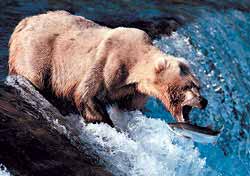 If you surprise a grizzly, make sure it has an escape route, then stand still or move slowly and quietly away. |
If you encounter a mountain lion, do
- make yourself look bigger by raising your arms slowly, opening your jacket, etc., and slowly backing away.
- band together in a group.
- speak in a loud voice.
- give the animal room for escape.
- face the cat; maintain eye contact.
- fight back if attacked.
- dislodge an attack from behind by throwing the cat over you and forward.
If you encounter a mountain lion, do not
- turn your back or bend over to pick up a child or a weapon. This invites attack.
- run. This makes you seem more like prey, and mountain lions have superior speed.
- roll into a ball if under attack—because the best action is to fight back, not surrender.
Moose, Elk, And Bison
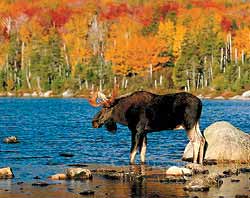 Moose and other ungulates are most likely to charge when threatened or crowded. |
Ungulates are hoofed mammals such as moose, elk, and bison. These animals are likely to charge when threatened or crowded. Ungulates can be especially aggressive, using antlers, horns, teeth, and hooves during mating season or to protect their young.
Although attacks can be fatal to humans, they are rare. You are, however, at greater risk in Yellowstone National Park of being charged by a buffalo than you are of being attacked by a grizzly.
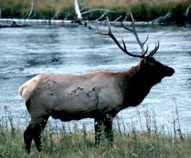 Using antlers, horns, teeth, and hooves, elk can be especially aggressive during mating season or protecting their young. BSA Archives |
Should you find yourself faced with an aggressive ungulate, quietly back away. Climb or stand behind a tree if you are charged. These animals are fast, so running is not an option.
Remember, the chances of a damaging or fatal wildlife encounter are rare. Knowledge can help you avoid confrontations and safely come away from any encounters that might occur.
F. Lynne Bachleda is the author of Dangerous Wildlife in California and Nevada: A Guide to Safe Encounters at Home and in the Wild, as well as two other volumes in the Dangerous Wildlife series from Menasha Ridge Press, Birmingham, Ala.
Bear Bag Basics
Simply slinging a bag over a tree branch is insufficient. Bears have been known to leap from tree branches to snatch a bag, and large bears can reach low, weak branches under nine feet or climb out stronger limbs for food. (If a branch must be used, sling the bag far out on the tip of a branch larger than four inches in base diameter.) However, it's best to sling your food bags over a line or pole supported by two trees, so that the bags hang four feet below a branch or limb, at least six feet from the nearest tree trunk, and at least 12 feet from the ground. Bears sometimes chew through ropes to get hanging food bags. To guard against this, use two or three ropes to hang a bear bag. —F.L.B. |
Where Are They?
Black bears, favoring forests, are in the Appalachian mountain chain from northern Alabama and Georgia north into Maine; northern Wisconsin and Minnesota; most of Arkansas; central Florida; and coastal Alabama, Mississippi, and Louisiana. Western black bears are in Washington south to east-central California; Rocky Mountain states south to Mexico; southeastern Oklahoma; and northeastern and extreme west Texas. A "threatened" species, grizzly bears prefer mixed forests and meadows. They are in and around Yellowstone National Park; parts of Montana, including Glacier National Park; and portions of Idaho, Washington, and Colorado. They are also found in Alaska, where they are not protected by law. 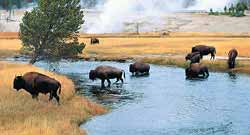
Mountain lions dwell in deserts, forests, mountains, grasslands, dry brush, and swamps from sea level to 10,000 feet. They inhabit the area west of the Rocky Mountains from Canada to Mexico. A small population of the Florida panther lives in the Everglades of southern Florida and in Apalachicola National Forest in the state's panhandle. Buffalo are in Yellowstone National Park and pockets of Alaska. Elk are in the northwestern United States; the Rockies; and down into the southwestern United States including New Mexico and Arizona, with isolated populations in Oklahoma, California, Utah, Nevada, South Dakota, Michigan, Minnesota, Pennsylvania, Kentucky, and Tennessee. Moose can be found across the northernmost United States from Maine to Washington and south to Pennsylvania and into the Rockies in Utah and Colorado. They are also in Alaska. —F.L.B. |
First Aid for InjuriesShould you be bitten or mauled by a wild animal, the basic field treatment is the same for all types of wounds that may cause infection:
—F.L.B. |
January - February 2004 Table of Contents
Copyright © 2004 by the Boy Scouts of America. All rights thereunder reserved; anything appearing in Scouting magazine or on its Web site may not be reprinted either wholly or in part without written permission. Because of freedom given authors, opinions may not reflect official concurrence.
